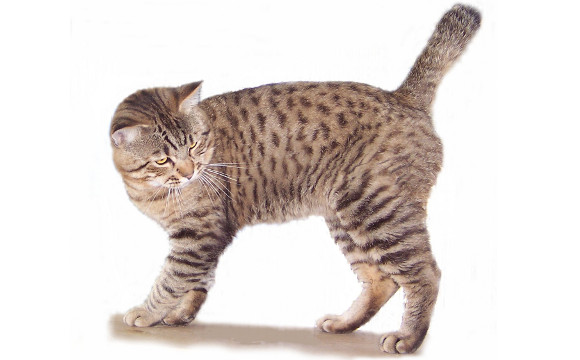History and Origins
The American Bobtail cat, a breed with a relatively recent development, dates back to the late 1960s. The breed’s origins are somewhat mysterious, but it began with a short-tailed brown tabby male named Yodie, believed to be a hybrid of a bobcat and a domestic cat. John and Brenda Sanders acquired Yodie during a vacation near an Indian reservation in Arizona. Yodie mated with a seal point Siamese female, and their offspring laid the foundation for the American Bobtail breed.
Early breeders faced numerous challenges, including the difficulties of stabilizing the breed’s unique genetic traits. Initial efforts saw the introduction of Birman, Himalayan, and Himalayan/Siamese crossbreeds into the bloodline. Mindy Schultz, an early breeder, drafted the first provisional breed standard in the early 1970s. However, due to inbreeding and other obstacles, the original bloodlines were phased out by the mid-1980s.
A new group of breeders then focused on creating a more diverse and robust American Bobtail, emphasizing the wild look of the bobcat while maintaining a friendly and domestic temperament. This effort led to the establishment of the modern American Bobtail, recognized in various colors and coat patterns.
Physical Characteristics
The American Bobtail is known for its wild appearance and distinctive short tail, which is about one-third to one-half the length of a normal cat’s tail. Key physical traits include:
- Body: The breed has a moderately long, substantial, and stocky body with a noticeable rectangular stance. The chest is broad, and the hips are substantial.
- Head: Broad, modified wedge-shaped head with a concave curve between the nose and brow. The muzzle is broad, and the whisker pads are noticeable.
- Ears: Medium-sized, wide at the base with slightly rounded tips. Ear furnishings are desirable, and lynx tipping is preferred.
- Eyes: Oval to large almond-shaped, set deep, and angled towards the base of the ears. Eye color varies with the coat color.
- Tail: The tail can be straight, slightly curved, have bumps, or be knotted. It must be clearly visible above the back and should not extend past the hock.
- Coat: Comes in two lengths—short and long. The shorthair has a medium-short, resilient double coat, while the longhair has a semi-long, shaggy double coat with longer hair on the ruff, britches, belly, and tail.
Personality and Temperament
American Bobtails are playful, energetic, and intelligent cats. They are known for their:
- Affectionate Nature: They form strong bonds with their human companions and enjoy being involved in family activities.
- Curiosity and Intelligence: Their high intelligence makes them adept at solving problems, and they are known for their Houdini-like escapes from closed rooms or cages.
- Playfulness: These cats enjoy interactive play and need plenty of physical and mental stimulation.
- Sociability: They are very people-oriented and will often demand attention by meowing or climbing into laps.
Care and Maintenance
American Bobtails are relatively easy to care for, but they do require some specific attention to ensure their health and well-being:
- Diet: A balanced diet rich in high-quality protein is essential to support their muscular build and active lifestyle. Consult with a veterinarian for specific dietary recommendations.
- Exercise: Regular play sessions with interactive toys and climbing structures help keep them physically fit and mentally stimulated.
- Grooming: Regular brushing, especially for longhaired Bobtails, helps maintain their coat and reduces shedding. Checking their ears, teeth, and claws regularly is also important for overall health.
- Health Check-ups: Regular veterinary check-ups are crucial to monitor their health and address any potential issues early.
Health Considerations
American Bobtails are generally healthy, but they can be prone to certain genetic conditions. Regular veterinary care and a healthy lifestyle can mitigate many of these risks. Some common health concerns include:
- Hip Dysplasia: A condition that affects the hip joints, more common in larger breeds.
- Obesity: Maintaining a healthy weight through diet and exercise is crucial to prevent obesity-related health issues.
- Heart Conditions: Regular screenings can help detect and manage any heart-related problems.
Breeding and Population
Breeding American Bobtails requires careful attention to genetic diversity to maintain the breed’s health and distinctive traits. Outcrossing to domestic cats is still allowed to keep the gene pool healthy, but bobcats and other breeds like the Manx or Japanese Bobtail are not used. The breed has grown in popularity, but its gene pool remains relatively small.
American Bobtail Cats in Popular Culture
The American Bobtail’s wild appearance and friendly nature have made it a favorite among cat enthusiasts. Its unique look and playful personality have led to features in various media, further boosting the breed’s profile.
Choosing an American Bobtail Cat
If you’re considering adding an American Bobtail cat to your family, it’s important to choose a reputable breeder. Here are some tips:
- Research: Learn about the breed’s characteristics, care requirements, and potential health issues. Understanding the breed will help you make an informed decision.
- Visit Breeders: Visit breeders in person to see their cats and facilities. A reputable breeder will be transparent about their breeding practices and happy to answer your questions.
- Ask for Health Records: Ensure that the breeder provides health records for the kitten and its parents. This information is crucial for understanding the cat’s health background.
- Consider Adoption: While purebred kittens from breeders are common, don’t overlook adoption. Many American Bobtails end up in shelters or breed-specific rescues in need of a loving home.
Conclusion
The American Bobtail cat is a unique blend of wild aesthetics and domestic charm. Their playful, affectionate nature, combined with their striking appearance, makes them an excellent choice for cat lovers seeking a companion that stands out. Proper care, a balanced diet, and regular veterinary check-ups are essential to ensure a long and healthy life for these magnificent cats.
By understanding and supporting the American Bobtail cat, you contribute not only to the well-being of a beautiful breed but also to the broader appreciation and preservation of unique feline traits. Whether you’re a seasoned cat owner or new to the world of exotic breeds, the American Bobtail offers a rewarding and enriching experience.
For more information and resources, visit the original article on American Bobtail Cat Breed.

